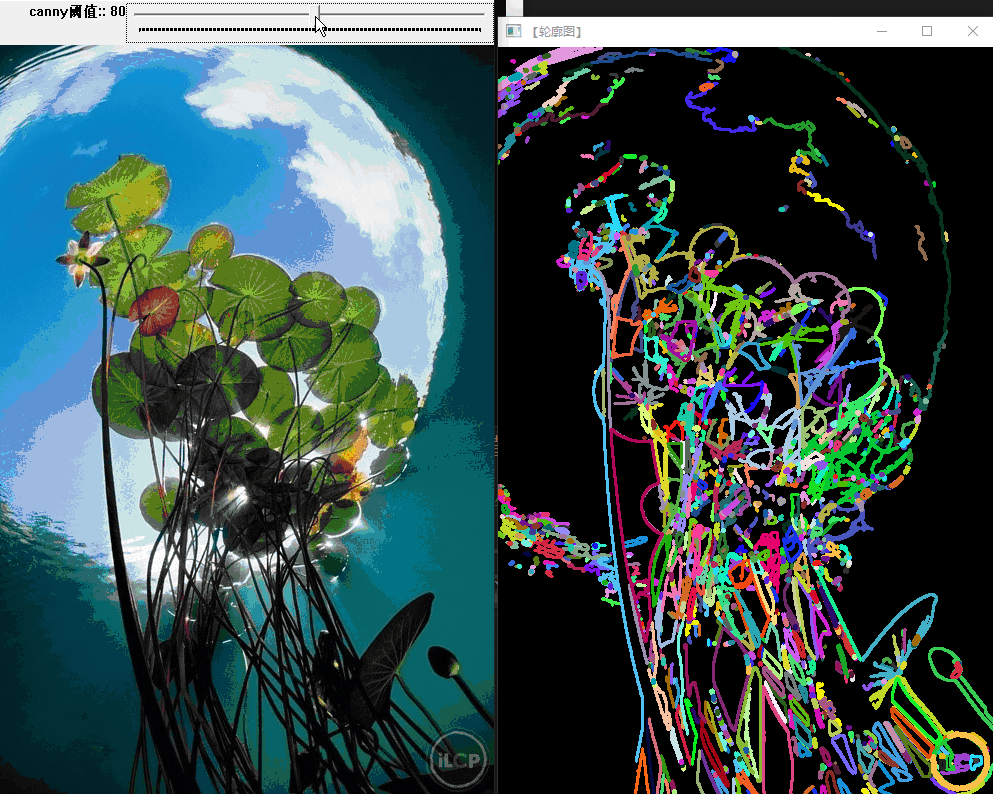查找并绘制轮廓综合示例
视频讲解如下:
当前系列所有demo下载地址:
https://github.com/GaoRenBao/OpenCv4-Demo
不同编程语言对应的OpenCv版本以及开发环境信息如下:
语言 | OpenCv版本 | IDE |
C# | OpenCvSharp4.4.8.0.20230708 | Visual Studio 2022 |
C++ | OpenCv-4.5.5-vc14_vc15 | Visual Studio 2022 |
Python | OpenCv-Python (4.6.0.66) | PyCharm Community Edition 2022.1.3 |
本章节是根据上一节内容进行整理的,代码集成了上一节的功能以及毛星云的轮廓查找功能。C#和Python也都是在C++版本的基础上转换过来的,三个版本的效果基本一致。
首先我们需要准备一张测试图片:

三组代码运行效果都是一样的,我这里就不一一展示了,最终运行效果如下,我这里拿C#版本的做个效果演示。

C#版本代码如下:
C#版本需要安装“OpenCvSharp4”、“OpenCvSharp4.runtime.win”两个库才行。不然会报错。
如果需要使用“ BitmapConverter.ToBitmap”操作,则需要追加安装“OpenCvSharp4.Extensions”库。
using OpenCvSharp;
using System;
namespace ConsoleApp
{
internal class Program
{
static string WINDOW_NAME1 = "【原始图窗口】";//为窗口标题定义的宏
static string WINDOW_NAME2 = "【轮廓图】";//为窗口标题定义的宏
static Mat drawing = new Mat();
static Mat g_srcImage = new Mat();
static Mat g_grayImage = new Mat();
static Mat g_cannyMat_output = new Mat();
static int g_nThresh = 80;
static int g_nThresh_max = 255;
static Random g_rng = new Random();
static void on_ThreshChange(int pos, IntPtr userData)
{
#if true
// 用Canny算子检测边缘
Cv2.Canny(g_grayImage, g_cannyMat_output, g_nThresh, g_nThresh * 2, 3);
// 寻找轮廓
Point[][] g_vContours = new Point[][] { };
HierarchyIndex[] g_vHierarchy;
Cv2.FindContours(g_cannyMat_output, out g_vContours, out g_vHierarchy, RetrievalModes.Tree, ContourApproximationModes.ApproxSimple, null);
// 绘出轮廓
drawing = new Mat(g_srcImage.Size(), MatType.CV_8UC3);
for (int i = 0; i < g_vContours.Length; i++)
{
//随机生成bgr值
int b = g_rng.Next(255);//随机返回一个0~255之间的值
int g = g_rng.Next(255);//随机返回一个0~255之间的值
int r = g_rng.Next(255);//随机返回一个0~255之间的值
Cv2.DrawContours(drawing, g_vContours, i, new Scalar(b, g, r), 2, LineTypes.Link8, g_vHierarchy);
}
#else
g_grayImage.CopyTo(g_cannyMat_output);
Cv2.Threshold(g_cannyMat_output, g_cannyMat_output, g_nThresh, 255, ThresholdTypes.Binary);
// 寻找轮廓
drawing = new Mat(g_cannyMat_output.Size(), MatType.CV_8UC3);
Point[][] contours = new Point[][] { };
HierarchyIndex[] hierarcy;
Cv2.FindContours(g_cannyMat_output, out contours, out hierarcy, RetrievalModes.CComp, ContourApproximationModes.ApproxSimple, null);
// 绘出轮廓
for (int index = 0; index < contours.Length; index++)
{
//随机生成bgr值
int b = g_rng.Next(255);//随机返回一个0~255之间的值
int g = g_rng.Next(255);//随机返回一个0~255之间的值
int r = g_rng.Next(255);//随机返回一个0~255之间的值
Cv2.DrawContours(drawing, contours, index, new Scalar(b, g, r), -1, LineTypes.Link8, hierarcy);
}
#endif
// 显示效果图
Cv2.ImShow(WINDOW_NAME2, drawing);
}
static void Main(string[] args)
{
// 加载源图像
g_srcImage = Cv2.ImRead("../../../images/flowers2.jpg");
// 转成灰度
Cv2.CvtColor(g_srcImage, g_grayImage, ColorConversionCodes.BGR2GRAY);
// 创建窗口
Cv2.NamedWindow(WINDOW_NAME1, WindowFlags.AutoSize);
Cv2.ImShow(WINDOW_NAME1, g_srcImage);
//创建滚动条并初始化
Cv2.CreateTrackbar("canny阈值:", WINDOW_NAME1, ref g_nThresh, g_nThresh_max, on_ThreshChange);
// 轮询等待用户按键,如果ESC键按下则退出程序
while (true)
{
if ((char)Cv2.WaitKey(20) == 27)
{
break;
}
}
}
}
}
C++版本代码如下:
#include "opencv2/highgui/highgui.hpp"
#include "opencv2/imgproc/imgproc.hpp"
#include <iostream>
using namespace cv;
using namespace std;
#define WINDOW_NAME1 "【原始图窗口】" //为窗口标题定义的宏
#define WINDOW_NAME2 "【轮廓图】" //为窗口标题定义的宏
Mat g_srcImage;
Mat g_grayImage;
int g_nThresh = 80;
int g_nThresh_max = 255;
RNG g_rng(12345);
Mat g_cannyMat_output;
vector<vector<Point>> g_vContours;
vector<Vec4i> g_vHierarchy;
void on_ThreshChange(int, void*)
{
#if true
// 用Canny算子检测边缘
Canny(g_grayImage, g_cannyMat_output, g_nThresh, g_nThresh * 2, 3);
// 寻找轮廓
findContours(g_cannyMat_output, g_vContours, g_vHierarchy, RETR_TREE, CHAIN_APPROX_SIMPLE, Point(0, 0));
// 绘出轮廓
Mat drawing = Mat::zeros(g_cannyMat_output.size(), CV_8UC3);
for (int i = 0; i < g_vContours.size(); i++)
{
Scalar color = Scalar(g_rng.uniform(0, 255), g_rng.uniform(0, 255), g_rng.uniform(0, 255));//任意值
drawContours(drawing, g_vContours, i, color, 2, 8, g_vHierarchy, 0, Point());
}
#else
g_grayImage.copyTo(g_cannyMat_output);
g_cannyMat_output = g_cannyMat_output > g_nThresh;
// 寻找轮廓
findContours(g_cannyMat_output, g_vContours, g_vHierarchy, RETR_CCOMP, CHAIN_APPROX_SIMPLE);
// 绘出轮廓
Mat drawing = Mat::zeros(g_cannyMat_output.size(), CV_8UC3);
int index = 0;
for (; index >= 0; index = g_vHierarchy[index][0])
{
Scalar color(rand() & 255, rand() & 255, rand() & 255);
drawContours(drawing, g_vContours, index, color, FILLED, 8, g_vHierarchy);
}
#endif
// 显示效果图
imshow(WINDOW_NAME2, drawing);
}
int main(int argc, char** argv)
{
// 加载源图像
g_srcImage = imread("../images/flowers2.jpg");
if (!g_srcImage.data) { printf("读取图片错误,请确定目录下是否有imread函数指定的图片存在~! \n"); return false; }
// 转成灰度并模糊化降噪
cvtColor(g_srcImage, g_grayImage, COLOR_BGR2GRAY);
//blur(g_grayImage, g_grayImage, Size(3, 3));
// 创建窗口
namedWindow(WINDOW_NAME1, WINDOW_AUTOSIZE);
imshow(WINDOW_NAME1, g_srcImage);
//创建滚动条并初始化
createTrackbar("canny阈值", WINDOW_NAME1, &g_nThresh, g_nThresh_max, on_ThreshChange);
on_ThreshChange(0, 0);
waitKey(0);
return(0);
}
Python版本代码如下:
import cv2
import numpy as np
import random
def zh_ch(string):
return string.encode("gbk").decode(errors="ignore")
g_nThresh = 80
# 修改对比度
def on_ThreshChange(x):
global g_nThresh, g_grayImage
g_nThresh = cv2.getTrackbarPos('g_nThresh', 'dstImage')
################################################################
# 用Canny算子检测边缘
g_cannyMat_output = edge=cv2.Canny(g_grayImage,g_nThresh,g_nThresh * 2,3)
# 查找轮廓
contours, hierarchy = cv2.findContours(g_cannyMat_output,cv2.RETR_TREE,cv2.CHAIN_APPROX_SIMPLE)
imgH = g_grayImage.shape[0]
imgW = g_grayImage.shape[1]
dstImage = cv2.UMat((imgW, imgH), cv2.CV_8UC3)
for i in range(0,len(contours)):
cv2.drawContours(dstImage, contours, i, (random.randint(0,255), random.randint(0,255), random.randint(0,255)), 2, 8, hierarchy)
################################################################
#ret,g_cannyMat_output = cv2.threshold(g_grayImage,g_nThresh,255,cv2.THRESH_BINARY)
## 查找轮廓
#contours, hierarchy = cv2.findContours(g_cannyMat_output,cv2.RETR_CCOMP,cv2.CHAIN_APPROX_SIMPLE)
#imgH = g_grayImage.shape[0]
#imgW = g_grayImage.shape[1]
#dstImage = cv2.UMat((imgW, imgH), cv2.CV_8UC3)
#for i in range(0,len(contours)):
# cv2.drawContours(dstImage, contours, i, (random.randint(0,255), random.randint(0,255), random.randint(0,255)), -1, 8, hierarchy)
################################################################
cv2.imshow("dstImage", dstImage)
cv2.waitKey(30)
# 【1】载入原始图
g_grayImage = cv2.imread("../images/flowers2.jpg")
cv2.imshow(zh_ch("原始图"), g_grayImage)
# 创建窗口
cv2.namedWindow('dstImage')
cv2.createTrackbar('g_nThresh', 'dstImage', 0, 255, on_ThreshChange)
cv2.setTrackbarPos('g_nThresh', 'dstImage', 80)
while (True):
if cv2.waitKey(10) == ord('q'):
break
cv2.destroyAllWindows()





